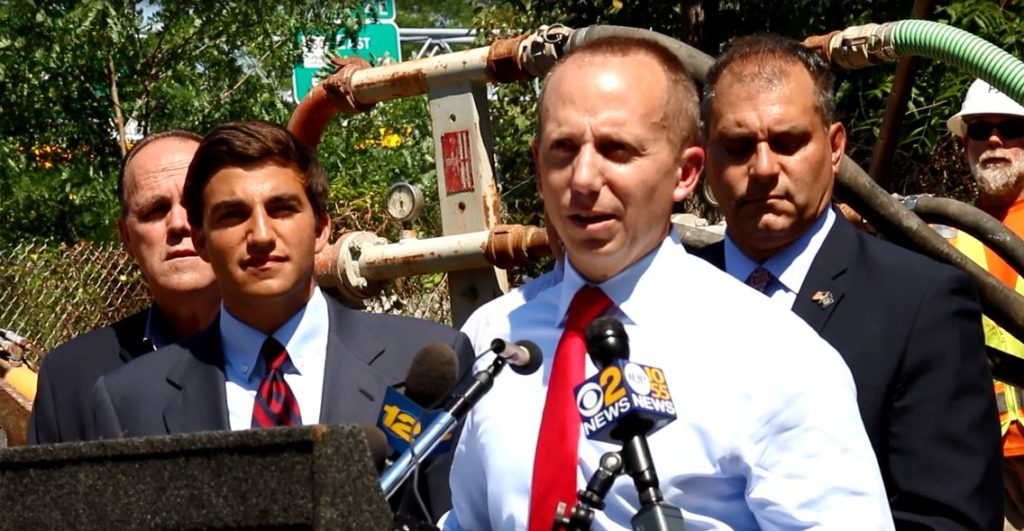
With a huge drilling rig as a backdrop, New York State Department of Environmental Conservation (DEC) Commissioner Basil Seggos and other officials announced the latest front in the war on the the Navy/Northrop Grumman plume.
Officials gathered on Aug. 11 at a State Department of Transportation property bordered by State Route 135 and Seamans Neck Road in Seaford. Technicians readied the first of two vertical profile borings [VPB], meant to establish the migrating plume’s furthest reach.
Jason Pelton, the DEC’s project manager, said the well “would support our feasibility study, our detailed analysis of different remedial options relating to the…plume. We’re putting in this [VPB} along the very southern margin of the groundwater plume. This is the southernmost [VPB] and…will give us insights on the groundwater quality and subsurface geology.”
Seggos told Anton Media Group, “My job as always is to apply the best possible science to fix the problems. I have a sense right now that more could be done [about the plume]. It’s not my own feeling, it’s actually the feeling of many people down here. The water districts are dealing with this problem on a daily basis. Are there other new contaminants? Is the plume somewhere we didn’t expect it to be? Is it moving faster toward Massapequa or [South] Farmingdale [water districts]? If the answer to those is yes, then we need to…begin to put in place more aggressive treatment technologies. We need to stop the plume.”
“Why this spot?” he was asked.
“This is a very important spot [because] we wanted to look at the leading edge of the plume,” Seggos replied. “If we have as our objective to contain the plume, we have to know how fast the water is flowing at those levels. And whether or not the plume can be intercepted by pumping it out. Then the question becomes, what do you do with the water?
You got to find a place to put the water. So it’s a very complicated engineering investigation. My team is doing some world-class science right now. We’ve got a partnership with the United States Geological Survey on this. We’re applying incredible data sets that were not available 10, 15 years ago. Today is an important chance for us to dig deep into that plume to find out what we could do.”
Seggos gave credit to Cuomo, noting, “The governor understands the seriousness of this problem. I think you have a level of attention being paid at his level that’s never happened with any prior administration.”
He added, “He’s given me and the DEC every tool I’ve ever asked for to go after any kind of pollution problem. This is certainly no exception. He launched a $2 million-plus study we’re doing right now. He’s directed me to do any number of things here to get this under control. He’s personally involved in this and wants to see it done quick.”
The DEC’s environmental consultant, HDR, operates the rig and will drill to a depth of approximately 800 feet. The operations will be paid for through the New York State Superfund program, and will be used to develop effective containment options. The DEC then aims to recover all expenses from the polluters.
According to a press release, “The work poses no exposure risk to community residents. In addition, as an added precaution, a DEC-approved community air monitoring program is being implemented during the drilling. At the governor’s direction, DEC will be holding a community meeting this fall to discuss preliminary outputs of the modeling and options for containment, and address any questions and concerns from area residents.”
Town of Oyster Bay Supervisor Joseph Saladino said, “Fourteen years ago, in the New York State Assembly, I bought up the issue of the Grumman-Navy plume. I put numerous bills before the state legislature to clean it up. The main one passed under my name was a comprehensive study by the DEC that led {to the conclusion] that the plume can be hydraulically contained and fully remediated.”
Standing in front of the rig with the commissioner and water district representatives, Saladino said that “the construction of the [clean water] infrastructure must begin now. We must remediate the plume, and today is one of those important steps toward putting getting that done. In the Town of Oyster Bay we’re doing our part by requiring Grumman and the Navy to test for 1,4 dioxane and many contaminants and breakdown products in our [groundwater]. The [town], in connection and cooperation with the DEC, has also extended soil testing requirements for the area of Bethpage Community Park known as the baseball field. We want that done. We want it cleaned up 100 percent.”
The Bethpage Water District has been most the one effected by the plume. Superintendent Mike Boufis was on hand and said the well will “give us more info on how this plume is moving.”
He noted that a monitoring well about 700 yards north of the DOT site has, at 761 feet, picked up samples of the most common contaminant, trichloroethylene (TCE) at 17 parts per billion (ppb) when tested last December. The drinking water standard is 5 ppb. That well, just north of the Southern State Parkway, is the southernmost to sample TCE at double digits.
“That’s why this vertical profile boring [being drilled] is so important,” noted Boufis. “It’s downgradient of that well so there is a bit of a warning system…it will be converted into a monitoring well. They could eventually build a pump treatment system here.”


















